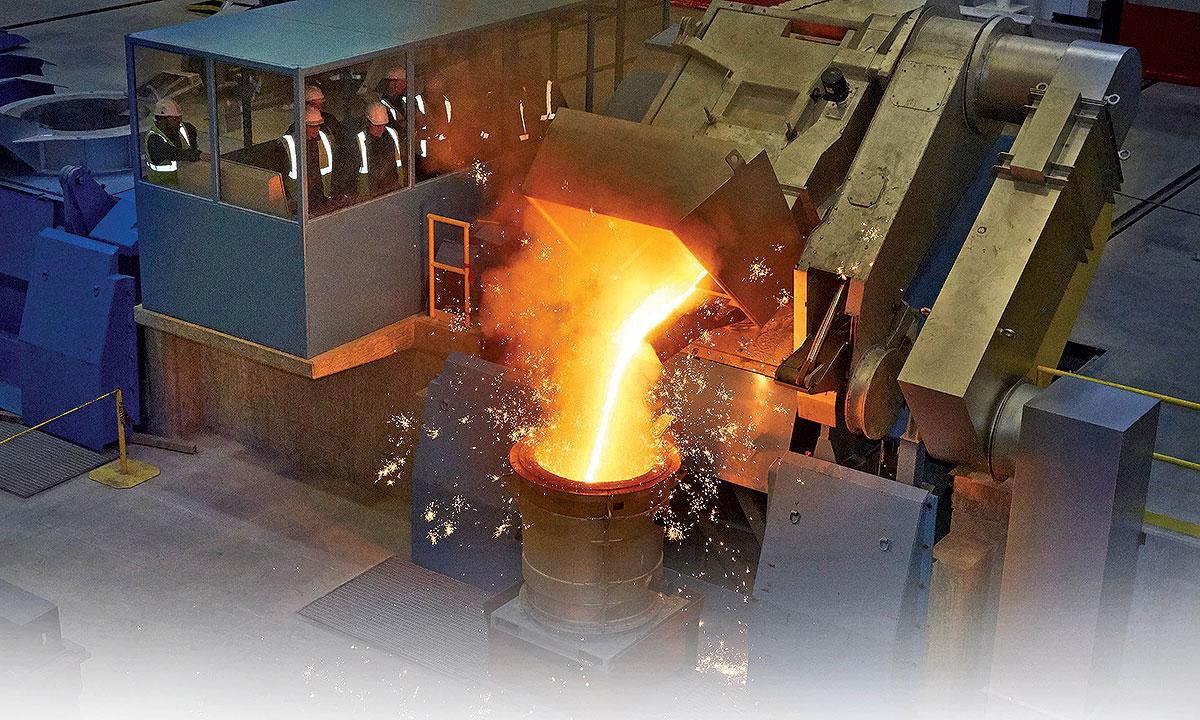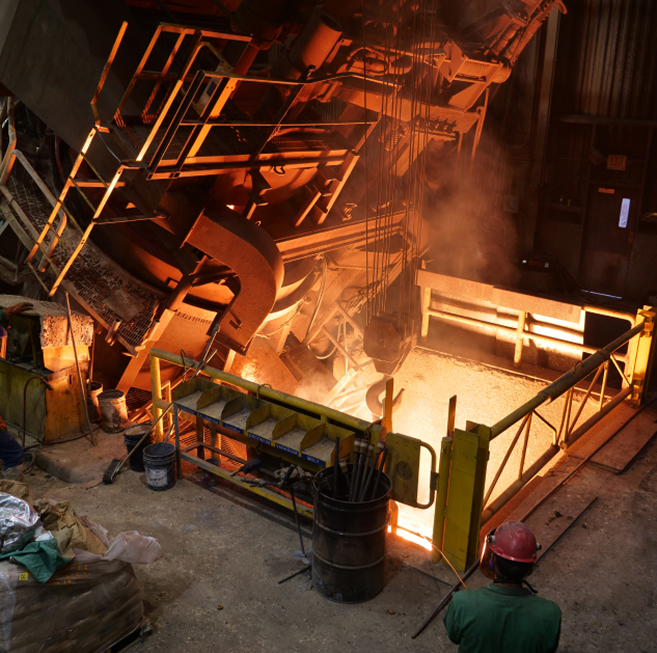Discover the Ingenious Strategies Made Use Of in a Metal Foundry for Superior Casting Results
In today's competitive manufacturing landscape, metal foundries are progressively adopting ingenious strategies to boost spreading results - Aluminum Foundry. Advanced computer system simulations permit specific modeling of molten metal habits, while 3D printing enables fast manufacturing of intricate molds. Furthermore, environmentally friendly materials and automation simplify procedures. These growths assure significant improvements in effectiveness and quality assurance. Nevertheless, the impact of these innovations on sustainability and manufacturing practices stays to be totally explored
Advanced Computer System Simulations in Metal Casting
Advanced computer system simulations have changed the metal spreading procedure by boosting accuracy and performance. These advanced tools allow designers to produce digital designs of cast parts, allowing them to analyze and predict the actions of liquified metal during the casting phase. By imitating numerous criteria such as temperature, flow rate, and cooling rates, manufacturers can determine prospective issues prior to physical production begins.
This positive strategy reduces waste and reduces pricey mistakes, ultimately leading to boosted item quality. Furthermore, simulations assist in the optimization of mold and mildew designs, making sure that they satisfy the specific demands of each job. The assimilation of computational fluid dynamics (CFD) and limited aspect evaluation (FEA) additional adds to the accuracy of these simulations, providing insights that were formerly unattainable. Therefore, advanced computer system simulations have become an important component of modern metal foundries, greatly progressing the market's capacities.
3D Printing for Molds and Patterns
3D printing has actually arised as a groundbreaking technique for producing mold and mildews and patterns in the metal foundry market. This modern technology enables the fast manufacturing of complex geometries that traditional manufacturing approaches struggle to accomplish. By utilizing additive manufacturing, foundries can create complex layouts with reduced lead times and product waste. The capacity to produce molds on need permits greater versatility in layout models, promoting faster prototyping and adjustments.
3D printing can make use of a variety of materials, consisting of plastics and metals, customized to certain casting requirements. This adaptability enhances the precision of mold and mildews, causing superior casting outcomes with improved surface area coatings. Furthermore, the decrease in the number of components needed streamlines setting up procedures, better enhancing manufacturing efficiency. As foundries proceed to take on 3D printing, they are positioned to redefine industry requirements, leading the way for innovation and improved efficiency in metal casting operations.
Eco-Friendly Products and Processes
As the metal foundry sector deals with raising pressure to decrease its environmental impact, the fostering of environment-friendly materials and procedures has actually become crucial. Shops are now exploring sustainable choices to standard materials, such as using recycled steels and bio-based binders. These products not just minimize waste however also reduced power usage during manufacturing.
In addition, improvements in sand casting methods have actually resulted in making use of synthetic sands that are much less dangerous to the environment. Shops are additionally carrying out innovative procedures like molten metal treatment that reduces discharges and improves the top quality of cast items.
Additionally, water-based coverings have actually changed toxic solvents, advertising a safer job environment (Metal our website Casting). By integrating these environmentally friendly techniques, metal foundries can considerably reduce their ecological impact while preserving top quality spreading results. This shift not just profits the setting but also straightens with the expanding consumer demand for lasting production options
Automation and Robotics in Foundry Operations
While the metal foundry sector welcomes development, the combination of automation and robotics is changing procedures greatly. Automated systems enhance processes such as mold and mildew production, metal putting, and casting finishing, significantly enhancing effectiveness. Robotics assist in the handling of hefty products, lowering the risk of workplace injuries and guaranteeing more secure settings.

Additionally, making use of automated led vehicles (AGVs) enhances material transportation within centers, making sure prompt delivery of components to ideal workstations. By carrying out these innovations, foundries can adjust to fluctuating demands with better agility, inevitably causing enhanced profitability and competition out there. As automation and robotics proceed to evolve, they hold the potential to redefine traditional foundry techniques and drive additional innovations in casting techniques.
Real-Time Tracking and Quality Assurance Techniques
The improvements in automation and robotics have actually led the way for a lot more innovative methods to quality guarantee in metal foundries. Real-time monitoring systems make use of sophisticated sensors and data analytics to track important specifications throughout the casting process. These systems continually analyze variables such as pressure, temperature level, and material composition, allowing prompt detection of variances from established standards.
Quality control strategies currently include machine learning algorithms that evaluate historical information to predict potential problems prior to they take place. This proactive approach minimizes waste and improves general manufacturing effectiveness. In addition, incorporated responses loopholes permit why not try these out rapid adjustments, guaranteeing that each casting satisfies strict high quality requirements.
The execution of digital twins-- digital reproductions of physical possessions-- has additionally reinvented high quality assurance, permitting designers to replicate and optimize processes in real-time. With each other, these ingenious strategies significantly improve the reliability and quality of castings, establishing new market standards in metal foundry procedures.
Frequently Asked Concerns
What Sorts of Metals Are Generally Cast in Shops?
Frequently cast metals in foundries consist of light weight aluminum, iron, bronze, and brass. Each metal shows special homes, making them suitable for different applications, such as automotive components, machinery, and artistic sculptures, enhancing their adaptability in production.

For how long Does the Casting Refine Typically Take?
The casting procedure typically takes several hours to days, relying on elements such as the complexity of the mold and mildew, sort of metal made use of, and cooling demands. Each stage affects the overall duration markedly.
What Precaution Remain In Place for Foundry Workers?

How Are Defects in Castings Identified and Addressed?
Flaws in spreadings are recognized through aesthetic inspections and non-destructive testing techniques. Once found, foundry workers address them by refining procedures, readjusting product make-ups, and carrying out restorative steps to assure high quality and conformity with standards.
What Is the Expense Range for Metal Casting Providers?
The price variety for metal spreading services generally varies between $1 to $10 per pound, relying on aspects such as material kind, complexity of the design, and production quantity, influencing general pricing substantially.
In today's affordable production landscape, metal foundries are increasingly embracing click this site ingenious techniques to boost casting outcomes. As the metal foundry industry encounters enhancing stress to minimize its environmental impact, the adoption of green materials and procedures has become crucial. Foundries are currently exploring sustainable choices to conventional products, such as using bio-based binders and recycled steels. By integrating these eco-friendly techniques, metal foundries can significantly lower their ecological effect while keeping premium spreading results. The developments in automation and robotics have actually led the means for much more advanced strategies to quality assurance in metal foundries.